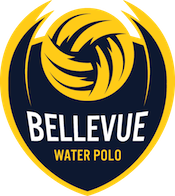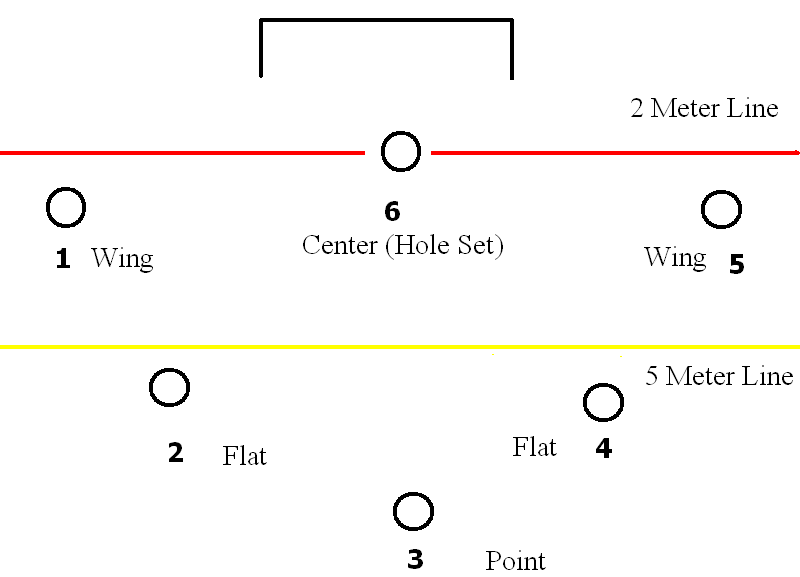Water polo is a combination of swimming, wrestling, basketball, soccer and baseball. It requires three basic fundamental skills: swimming, treading (egg-beater) and passing (ball skills). Six field players swim, tread, pass and shoot in an attempt to score into a goal defended by a goalie.
Basic water polo strategy is most similar to basketball. Teams set up a five-player semi-circle around the goal (the perimeter). Perimeter players can pass the ball, drive, set picks and shoot. A sixth player, the center (a.k.a. set), sits 2 meters out from the opposing team’s goal with his/her back facing the goal and attempts to get open for a shot. Positions in the pool are identified by numbers, listed in the diagram below:
Course and Markings
Olympic and collegiate pool size is 30 meters x 20 meters. A typical age group pool size is 25 yards x 6 lanes; much shorter and much narrower than an international regulation court. In Washington there are only regulation courts at Federal Way King County Aquatic Center and, Colman Pool and Curtis High School.
Three colored markers define the water polo course. Red markers indicate the 2-meter line. Offensive players cannot be inside the red marker unless the ball is also inside the red marker. Yellow markers indicate the 5-meter line. If an offensive player is fouled behind the yellow marker, he/she may shoot immediately (no faking or hesitating) or take a free pass. If an offensive player is fouled inside the yellow marker, he/she must take a free pass. White markers indicate mid-pool. After a goal, play re-starts at mid-pool. Goalies cannot cross the white marker.
Game Times and Shot Clock
Games are divided into four quarters. Quarter length depends on the level of play. Olympic and collegiate quarters are eight minutes. Age group quarters are typically five to six minutes. Teams may not have continuous possession of the ball for more than 30 seconds — this is called the shot clock. Shot clocks are re-set after turnovers, shots on goal and ejection fouls. Shot and game clocks stop when the ball is not “in play” (the time between a foul occurring and a free throw being taken) or a goal is scored.
Fouls
Fouls are critical to the strategy and flow of a water polo game. They occur frequently during offensive possessions. Referees signal fouls by blowing their whistle and pointing their arm in the direction of the team that was awarded the foul. Unlike most sports, defensive fouls are not always bad. Sometimes they are part of the defense strategy. Offensive players will sometimes attempt to “draw” a foul in order earn a free pass. It is not uncommon for more offensive motion immediately after a foul has been called.
- One whistle: minor/ordinary foul (offense keeps the ball)
- Two whistles: offensive foul (defense gets the ball)
- Three whistles: major/personal foul (offense keeps the ball while defender sits in penalty box for 20 seconds)
Minor (ordinary) Fouls
The most common minor foul is impeding the free movement of a player who is not holding the ball. To draw a foul, the offensive player must let go of the ball and show the referee that he/she is being held while keeping his/her head above water.
Other ordinary fouls include:
- Two hands (touching the ball with two hands)
- Ball under (taking the ball under water when pressured)
- Offensive foul (pushing off or head-butting a defender when holding the ball)
- Off the bottom (standing on the bottom of the pool)
- Delay of game (delaying too long before taking a free throw)
After a minor foul, a member of the fouled team must put the ball in play by taking a free throw. There is no limit to the number of minor fouls a player can commit.
Major (personal) Fouls
The most common major foul (a.k.a. kick-out) occurs when a defensive player holds, sinks or pulls back an offensive player that is not holding the ball. Other major fouls include interfering with a free pass or kicking/striking an opposing player.
Most major fouls result in the player being excluded for 20 seconds, causing his/her team to be temporarily down a player. Referees signal major fouls by blowing two short then one long whistle blast, pointing to the excluded player, and moving his/her arm towards the penalty area. The excluded player must sit in the penalty area for 20 seconds unless a goal is scored or a change of possession occurs. If a player commits three major fouls, they must sit out the remainder of the game.
Another common major foul is a penalty foul. Penalty foul occur when a defensive player commits a foul in the penalty area (inside the yellow marker and between the goal posts) that prevents a probable goal. After a penalty foul, the offensive team is awarded a penalty shot from the yellow marker.
Please note that officiating is subjective and open to interpretation by the referees.

